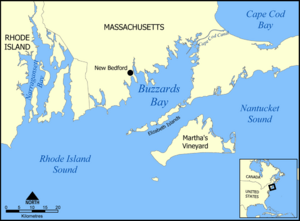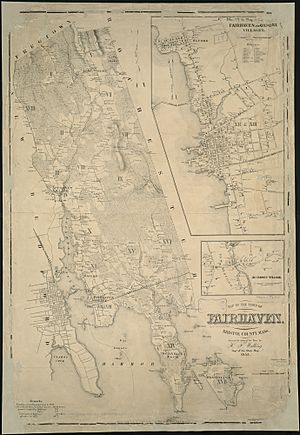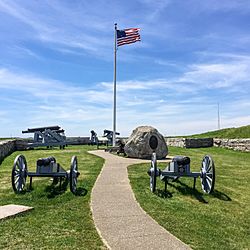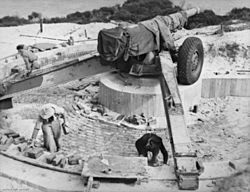Harbor Defenses of New Bedford facts for kids
Quick facts for kids Harbor Defenses of New Bedford |
|
|---|---|
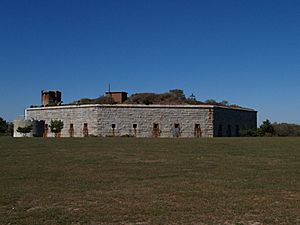
Fort Rodman
|
|
| Active | 1900-1950 |
| Country | |
| Branch | United States Army Coast Artillery Corps |
| Type | Coast artillery |
| Role | Harbor Defense Command |
| Part of |
|
| Garrison/HQ |
|
| Mascot(s) | Oozlefinch |
The Harbor Defenses of New Bedford was a special military command in the United States Army. Its main job was to protect the coastlines around New Bedford, Massachusetts, and the nearby Cape Cod Canal. This defense system was active from 1900 to 1950.
It included strong forts like Fort Rodman (also known as Fort Taber) and hidden underwater minefields. These defenses were part of a bigger plan to protect American harbors. The command changed its name a few times. It started as the New Bedford Artillery District around 1900. Then it became the Coast Defenses of New Bedford in 1913. Finally, it was renamed the Harbor Defenses of New Bedford in 1925.
Contents
History of New Bedford's Forts
Early Forts: Protecting the Coast
Revolutionary War and War of 1812
During the American Revolutionary War, two forts were built near New Bedford. One was an unnamed fort in 1775, later called Fort Phoenix, in what is now Fairhaven. It had six to eleven guns. The other was the 10-gun Acushnet Fort in 1776. Its exact location is not certain, but it might have been on Clark's Point, where Fort Rodman was later built.
The first fort was built after a naval battle on May 14, 1775. This battle, called the Battle off Fairhaven, is thought to be the first naval fight of the Revolution. About 30 American patriots on a ship called Success took back two vessels captured by a British ship, HMS Falcon. They even captured some British prisoners.
Another important event was Grey's raid in September 1778. British forces destroyed the Fairhaven fort. But a local force led by Major Israel Fearing fought them off. They stopped the British at the fort and again when they tried to attack the town the next day. After this, the fort was renamed Fort Fearing.
In 1784, Fort Fearing was renamed Fort Phoenix. This name came from the mythical bird that "rose from its ashes" because the fort was rebuilt. It was rebuilt again in 1798.
In 1808, both forts were made stronger. Fort Phoenix got 12 guns. Acushnet Fort, which was part of a federal defense plan, got six guns. Acushnet Fort was sometimes called the "fort at Eldridge Point." It was likely abandoned after the War of 1812.
During the War of 1812, a British ship, HMS Nimrod, attacked Fort Phoenix on June 13, 1814. The local soldiers refused to give up their guns. After some fighting, the Nimrod sailed away.
Civil War Era Forts
Construction began in 1857 on a new fort at Clark's Point. This fort was later named Fort Rodman in 1898. It was designed to hold 72 cannon on three levels. However, construction stopped in 1867, and the fort was never fully finished as planned.
When the American Civil War started in 1861, the Fort at Clark's Point was still far from ready. So, a smaller earthwork fort was quickly built nearby using city money. This temporary fort was called Fort Taber and had six cannons. It protected the area until the stone fort was ready in 1863. Today, a stone outline shows where Fort Taber once stood.
Fort Phoenix was also updated during the Civil War with eight 24-pounder cannons. It was no longer used after 1876.
Endicott Period: Modernizing Defenses
In 1885, a group called the Board of Fortifications suggested building new, modern defenses. For New Bedford, this meant new forts at Clark's Point. All the new defenses were placed at one location, which was officially named the Fort Rodman Military Reservation in 1898. It was named after Lieutenant Colonel Logan Rodman, a local hero who died in the Civil War.
The new weapons at Fort Rodman included:
- Two 8-inch "disappearing guns." These guns would pop up to fire and then lower back down for protection.
- Two 5-inch guns on special stands.
- Four 3-inch guns that could retract behind a wall.
The fort also had equipment to set up and control an underwater minefield. The fort was finished in 1902.
World War I: Changes and Upgrades
When the United States entered World War I, many changes happened at the Coast Defenses of New Bedford. Many temporary buildings were built at Fort Rodman for new soldiers. Some guns were removed from forts to be sent overseas.
Fort Rodman's 5-inch guns were sent to a US Army transport ship. Both of the fort's 8-inch guns were taken off their mounts in 1918 to possibly be used as railway artillery (guns on trains). However, they stayed at the fort and were put back in place in 1919. The 5-inch guns also came back in 1919, but by 1921, they were removed from service.
A big upgrade started at Fort Rodman during the war. This was Battery Milliken, which had two powerful 12-inch guns. These guns were on long-range mounts, meaning they could shoot much farther than the older disappearing guns. Their range increased from about 18,400 yards (16,800 meters) to 30,100 yards (27,500 meters). This battery was built between 1917 and 1921.
Between the World Wars
In 1920, Fort Rodman's 3-inch guns were removed and not replaced.
In 1925, the defense commands were renamed from "Coast Defenses..." to "Harbor Defenses...". The 23rd Coast Artillery Regiment was the main unit for the Harbor Defenses of New Bedford (HD New Bedford) during wartime. For most of the time between the wars, HD New Bedford was in "caretaker status," meaning only a small group of soldiers looked after it.
In 1938, a battery of two 155 mm guns was built at Fort Rodman. These guns were placed on "Panama mounts," which are circular concrete platforms. This helped make up for the lack of other medium-sized guns at the fort.
World War II: Expanding Defenses
At the start of World War II, many temporary buildings were again built at Fort Rodman for the rapid increase in soldiers and equipment. In early 1940, the 23rd Coast Artillery Battalion was called into action to protect HD New Bedford.
In 1942, the two 8-inch guns at Fort Rodman were removed. This left only the 12-inch Battery Milliken and the 155 mm battery active. Battery Milliken's guns were put inside casemates (strong concrete shelters) for protection against air attacks.
In 1943, the 23rd Coast Artillery Battalion grew into a full regiment. This was because new batteries were being built in southeastern Massachusetts.
Several new medium and small gun batteries were built in the New Bedford and Buzzards Bay area during World War II. One important one was Battery 210 at Mishaum Point Military Reservation in Dartmouth. It had two 6-inch guns on long-range mounts with a large bunker for ammunition and fire control. This battery also served as the "examination battery" for HD New Bedford. This meant it could stop and check ships entering the harbor.
To protect the passage to New Bedford, two batteries of 90 mm dual-purpose guns were built. These guns could fire at both ships and aircraft. One was at Barneys Joy Point Military Reservation and another on Cuttyhunk Island. These were called Anti-Motor Torpedo Boat Batteries (AMTB). An additional 90 mm battery was on Nashawena Island.
Protecting the southern entrance to the Cape Cod Canal was a 155 mm battery. This was later replaced in 1943 by a 90 mm AMTB battery at Butler Point Military Reservation in Marion.
In early 1944, the US Army changed its organization. The 23rd Coast Artillery was reduced back to a battalion. As the threat to the East Coast lessened, many coast defenses were scaled back.
The US Navy also helped protect the Buzzards Bay area. They used net defenses and special underwater cables called "indicator loops" to detect submarines.
After World War II
After the war, it became clear that large gun defenses were no longer needed. They were removed by the end of 1948. The remaining harbor defense tasks were given to the Navy. In 1950, the Coast Artillery Corps and all Army harbor defense commands were officially ended.
From the late 1940s to the mid-1970s, Fort Rodman was used as a military reserve center.
What Remains Today?
Today, the main parts left of the Harbor Defenses of New Bedford are Fort Rodman (located in Fort Taber Park) and Fort Phoenix.
The stone fort at Fort Rodman is still well-preserved. It is sometimes open to the public for special events. A stone outline shows where the Civil War-era Fort Taber once stood. The park also has a museum and a M4 Sherman tank. Many of the old buildings at Fort Rodman are still there. The University of Massachusetts Dartmouth uses some of them.
Fort Phoenix has several old 24-pounder cannons from the 1820s. It also has a cannon said to have been captured by the Continental Marines during a raid on Nassau in the Bahamas in 1776. This raid was the first time US Marines landed on foreign soil.
Coat of Arms
The Harbor Defenses of New Bedford had its own special coat of arms. It showed an arm holding a harpoon. This symbolized New Bedford's history as the "Whaling City."


